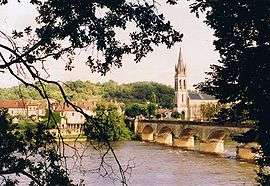Lalinde
| Lalinde | ||
|---|---|---|
|
Lalinde and the Dordogne River | ||
| ||
 Lalinde | ||
|
Location within Nouvelle-Aquitaine region  Lalinde | ||
| Coordinates: 44°50′16″N 0°44′20″E / 44.8378°N 0.7389°ECoordinates: 44°50′16″N 0°44′20″E / 44.8378°N 0.7389°E | ||
| Country | France | |
| Region | Nouvelle-Aquitaine | |
| Department | Dordogne | |
| Arrondissement | Bergerac | |
| Canton | Lalinde | |
| Intercommunality | Bassin Lindois | |
| Government | ||
| • Mayor (2008–2014) | Pierre Alain Péris | |
| Area1 | 27.7 km2 (10.7 sq mi) | |
| Population (2008)2 | 2,967 | |
| • Density | 110/km2 (280/sq mi) | |
| Time zone | CET (UTC+1) | |
| • Summer (DST) | CEST (UTC+2) | |
| INSEE/Postal code | 24223 / 24150 | |
| Elevation |
25–194 m (82–636 ft) (avg. 47 m or 154 ft) | |
|
1 French Land Register data, which excludes lakes, ponds, glaciers > 1 km² (0.386 sq mi or 247 acres) and river estuaries. 2 Population without double counting: residents of multiple communes (e.g., students and military personnel) only counted once. | ||
Lalinde (Occitan: La Linda) is a commune in the Dordogne department in Nouvelle-Aquitaine in southwestern France. It lies on the Dordogne River and was enclosed within fortified walls of which little remains today.
History
In its past, it was a strategically important military site being the first "English bastide town"; it suffered various sieges during the Hundred Years' War and again in 1562 and 1572 during the Wars of Religion.
The train station was built in 1877 and the bridge over the Dordogne River in 1880, though there are signs of earlier crossings including a ford going back to Roman times.
In 1944 the local Resistance paid a heavy price when on 21 June many of Lalinde's sons perished in the Mouleydier massacre.
Population
| Historical population | ||
|---|---|---|
| Year | Pop. | ±% |
| 1962 | 3,150 | — |
| 1968 | 3,291 | +4.5% |
| 1975 | 3,070 | −6.7% |
| 1982 | 2,949 | −3.9% |
| 1990 | 3,029 | +2.7% |
| 1999 | 2,989 | −1.3% |
| 2008 | 2,967 | −0.7% |
See also
References
External links
| Wikimedia Commons has media related to Lalinde. |

